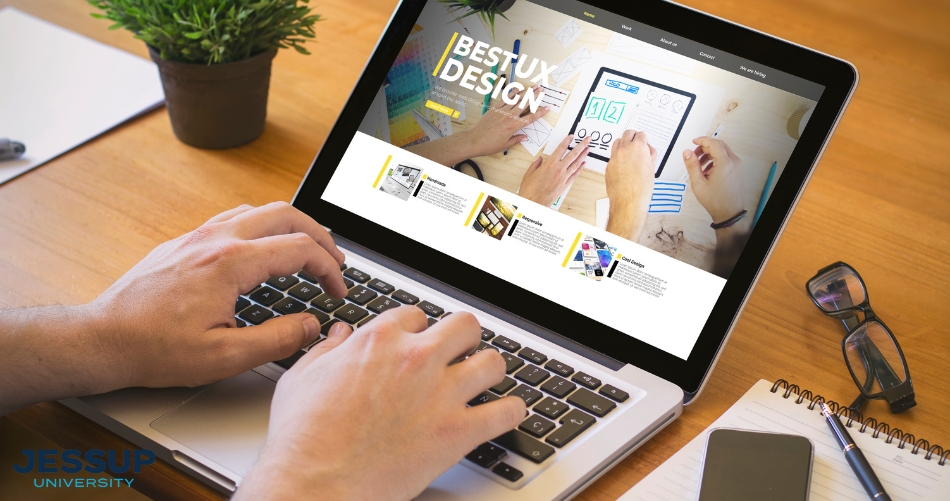Understand how Web Design services can increase your website’s traffic and ranking
Wiki Article
Discovering Imaginative Fads in Web Design for Modern Organizations
The landscape of web design is constantly developing, showing the dynamic needs of modern services. Current patterns highlight a choice for minimalism, vibrant typography, and appealing interactivity. Firms significantly prioritize user experience through mobile-first principles and personalized content. Furthermore, a focus on sustainability is gaining traction. Comprehending these fads is essential for businesses intending to stand apart in a congested market. What implications do these changes hold for the future of digital engagement?Accepting Vibrant Typography
Vibrant typography has actually arised as a specifying component in modern web design, recording interest and conveying messages with striking clearness. This pattern prioritizes aesthetically impactful text that boosts user engagement and brand name identification. Designers typically use special typefaces and large fonts to create a pecking order, guiding audiences with content perfectly.
The calculated usage of vibrant typography permits reliable storytelling, making it possible for brands to communicate their values succinctly. It serves not just visual objectives yet likewise functional ones, as it boosts readability across devices and display sizes.
As websites complete for user attention, strong typography sticks out in a saturated digital landscape. Its versatility allows developers to explore contrasting designs and shades, better enhancing its effectiveness. Eventually, welcoming bold typography represents a change towards more communicative and expressive web design, promoting a deeper connection between brand names and their audiences.
The Surge of Minimalist Layout
As electronic environments come to be increasingly messy, the increase of minimal layout supplies an invigorating option that prioritizes simplicity and performance. This layout philosophy remove unneeded components, enabling material to take center phase. By concentrating on clean lines, sufficient white area, and a limited color scheme, minimal style boosts user experience and improves navigating.Organizations embracing this pattern goal to share their brand message clearly and efficiently, cultivating a feeling of calmness and clearness. The lack of disturbances aids individuals focus on vital information, leading to boosted engagement and conversion prices. Additionally, minimal style lines up well with mobile-first strategies, making sure that sites remain user-friendly and accessible throughout various devices.
Inevitably, the surge of minimalist style mirrors a wider change in the direction of prioritizing user demands and choices, making it an effective tool for modern-day businesses wanting to make a lasting effect in the electronic landscape.
Immersive Animations and Interactivity
While many web designers welcome minimalist aesthetics, another compelling pattern obtaining traction is making use of immersive animations and interactivity. This method improves user interaction by developing interesting experiences that attract visitors into the content. Designers employ dynamic components such as computer animated histories, scrolling impacts, and interactive infographics to connect complex ideas in an easily accessible manner.These computer animations not just supply visual rate of interest but additionally guide users through the navigating process, making interactions extra user-friendly. As an example, hover impacts and animated shifts can urge customers to explore further, bring about enhanced time invested on the site.
This pattern aligns with the more comprehensive activity towards narration in web style, where computer animations serve as narrative gadgets that communicate brand messages successfully. By incorporating immersive animations and interactivity, businesses can distinguish themselves in a congested online landscape, ultimately boosting user complete satisfaction and brand name loyalty.
Mobile-First Layout Principles
Mobile-first design principles emphasize focusing on user experience by making certain sites function effortlessly on smaller sized screens. This approach integrates receptive format methods that adjust to different tool dimensions while preserving visual honesty. In addition, it concentrates on touchscreen navigation style, boosting usability for mobile individuals.Focusing On User Experience
Just how can designers properly prioritize user experience in an increasingly mobile-centric globe? Emphasizing mobile-first design principles is vital, as users primarily involve with internet sites via mobile tools. This technique motivates designers to improve content, ensuring it is accessible and quickly accessible on smaller sized displays. Secret practices consist of simplifying navigation, lessening load times, and utilizing touch-friendly components that enhance interactivity. Additionally, prioritizing understandable typography and user-friendly formats can greatly enhance user contentment. Designers need to continually gather user responses to refine their strategies, adjusting to evolving user demands and choices. By concentrating on these components, businesses can produce Learn More an engaging electronic experience that promotes loyalty and drives conversions, eventually lining up with the assumptions of today's mobile customers.Responsive Design Techniques
Developers embrace responsive layout methods to produce adaptive and flexible internet experiences that satisfy various screen sizes. This method prioritizes mobile-first design principles, making sure peak performance on smaller devices prior to scaling up for bigger displays. By using fluid grids, adaptable images, and media inquiries, developers can preserve a cohesive aesthetic identification across all systems. This strategy not only boosts user interaction but likewise improves search engine rankings, as mobile-friendly websites are favored by search algorithms. In addition, receptive designs permit services to get to a more comprehensive target market, fitting individuals on desktop computers, smartphones, and tablet computers alike. Overall, implementing these strategies is necessary for modern-day web design, making certain that companies stay competitive in an ever-evolving electronic landscape.Touchscreen Navigating Layout
With the increase of mobile devices, touchscreen navigating has actually ended up being a basic aspect of web design. Developers are progressively adopting mobile-first concepts to boost user experience and engagement. agency for web design. Efficient touchscreen navigating prioritizes bigger buttons and intuitive motions, enabling users to interact conveniently with content. This technique lowers irritation and urges expedition, as users can browse perfectly with their fingers. Furthermore, including swipe gestures and faucet performance satisfies the all-natural actions of mobile individuals. Responses devices, such as visual cues and computer animations, improve usability additionally by validating activities. As touchscreens dominate user communications, using these layout aspects not just aligns with modern assumptions however also promotes a much more obtainable and enjoyable surfing experience for all usersIndividualized User Experiences
What makes an individual really feel absolutely involved on an internet site? The solution usually depends on individualized user experiences. By tailoring content and navigating to specific preferences, companies can produce a significant connection with their target market. This personalization can be accomplished via various techniques, such as analyzing user actions, utilizing cookies, and providing personalized recommendations based upon previous interactions.For instance, e-commerce systems that suggest items based upon surfing background not only enhance user experience but additionally boost conversion rates. Including vibrant material that adjusts to the user's area or time of day can even more improve involvement.
Additionally, personalized introductions or messages can make customers feel valued and comprehended. As modern services endeavor to stick out in an affordable digital landscape, accepting personalized user experiences ends up being essential, promoting commitment and encouraging repeat brows through. Inevitably, this technique transforms a common internet site right into an interactive platform that reverberates with its target market.
Sustainability in Web Design
As the digital landscape remains to advance, the relevance of sustainability in web design has acquired substantial interest. Designers are increasingly familiar with the ecological effect their developments can have, motivating a change why not try these out towards green practices (Web Design Agency). Lasting web design concentrates on maximizing internet sites to reduce power intake and carbon footprints. Methods consist of utilizing Homepage minimalistic design principles, optimizing pictures, and utilizing reliable coding techniques to enhance loading speedsIn addition, the option of hosting providers plays a vital function; several designers are now choosing for eco-friendly hosting solutions powered by renewable resource. By focusing on ease of access and user-friendly navigating, lasting styles likewise deal with a broader target market, improving usability. This aware approach not only allures to environmentally-minded consumers but additionally adds to the general long life and effectiveness of sites. Eventually, sustainability in web design shows an expanding fad in the direction of accountable electronic methods that align with modern-day business values.

Regularly Asked Questions
Just How Can I Select the Right Color Design for My Web site?
To pick the best color design for an internet site, one need to think about the brand's identification, target audience, and emotional impact. Utilizing color theory and testing mixes can enhance user experience and aesthetic appeal considerably.What Are the very best Tools for Prototyping Website Design?
The ideal tools for prototyping website design include Figma, Lay out, Adobe XD, and InVision. These platforms supply user-friendly interfaces, partnership attributes, and extensive libraries, making them ideal for developers to develop and refine their concepts efficiently.How Do I Determine the Efficiency of My Web Design?
To measure web design performance, one ought to assess user interaction metrics, conversion prices, and functionality comments (web design company). A/B screening and heatmaps can additionally give understandings right into user habits, directing required adjustments for improved efficiency and user experienceWhat Are Usual Web Design Errors to Stay Clear Of?
Common web design mistakes consist of chaotic layouts, poor navigating, slow-moving packing times, absence of mobile optimization, inadequate comparison, and neglecting user responses. Avoiding these mistakes boosts user experience and increases overall effectiveness of the website.Just how Commonly Should I Update My Website Layout?
A website layout should be updated every 2 to 3 years, or sooner if significant modifications in branding or technology take place. Normal updates keep the site fresh, practical, and aligned with current user expectations.
Report this wiki page